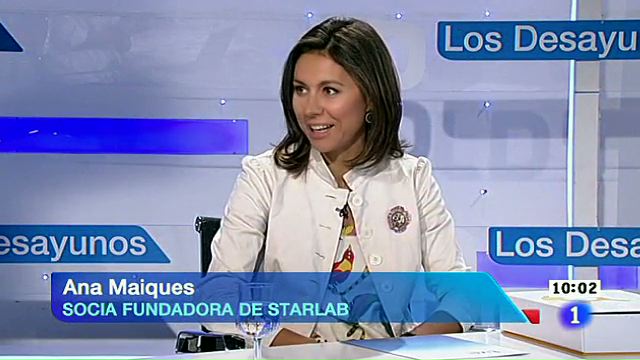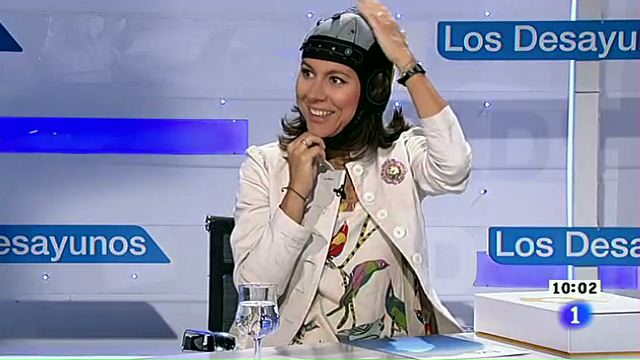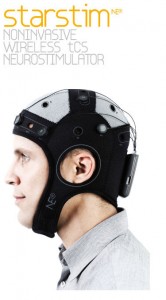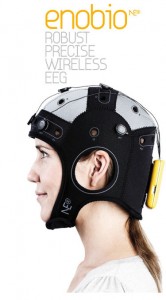Well here we go! Episode one of the DIY tDCS podcast. Ana Maiques is co-founder (with Giulio Ruffini) of Spanish-based Starlab. Their spin-off company, Neuroelectrics makes Enobio, a research-quality wireless EEG device, and Starstim, a multi-channel wireless tcs & tDCS device. Download the interview here (zipped mp3). Show notes after the fold.
(If you speak Spanish you might enjoy the interview these photos were taken from.) Also, if you’re an EEG or tDCS researcher or clinician (or VC) on the East Coast, Ana is frequently in the New York and Boston area and is happy to discuss Enobio and Starstim. Neuroelectrics will be at the Advances in Mediation Research conference in NY Jan. 17 2013. (Schedule) Check out the Neuroelectrics blog for excellent tDCS and EEG info.
Show Notes
Starlab is the parent company > Space (sensors) + Neuroscience
Cutting edge research > impact on society… products and services
Twelve years of research in neuroscience > Enobio, Starstim
Initial market is early adopters – researchers, clinicians and practitioners
Starstim (tDCS) > chronic pain, stroke rehabilitation (later… depression >> cognitive enhancement, addiction)
Medically certified in Europe and Canada
Filing 510k for Enobio in the US
Starstim has 8 channels for use as HD tDCS but can also use traditionally
Can also do tACS (alternating current), or random noise stimulation and at the same time Simultaneously record EEG
Can also use dry EEG electrodes
Roi Cohen Kadosh Oxford study, kids etc. (Link to video we discussed. NewScientist)
Study will determine if tDCS is efficacious in enhancing performance in certain areas (math)
Will have implications for people with Alzheimers
Partnerships with 15 hospitals doing research with Starstim
8 in U.S. and 7 in Europe. Different pathologies. Results to be published soon.
Post-stroke rehabilitation is a great place to see the effectiveness of tDCS
tDCS > Motor recovery… hand rehabilitation…
Can thereby measure the degrees of movement and improvement very objectively
Couple of groups showing very measurable results.
The Muse, Neurosky, Emotiv Home EEG devices?
Limitation is number of channels.
Started Enobio with 4 channels, but feedback from medical community lead to developing a 20 channel Enobio.
For certain applications – games, BCI etc, the home EEG devices might be fine
But we’re looking at the medical application of EEG.
Doctors and researchers require the maximum coverage of the head.
Signal quality is very important.
EEG application
Emotion recognition, neural marketing, traumatic brain injury – concussion
BCI – wheelchairs.
Sponsoring a conference in NY on meditation. Sloan Kettering pre-chemo
medications >> less pain, better toleration of treatment.
Spanish VCs even more conservative since crisis
Patents >> cloud-based database recording experimental data
Software runs on a Mac.
“We always said we want to be the Apple of neuroscience…”





Can anyone tell me if I can use a LM334Z in place of a LM334M? I’m attempting to build the tDCS by 55tfg7879fe42e345
The only reason I ask is because I wouldn’t know what to do the the 8 prongs on the LM334M.
heye
i was interested in buying starstim . Could you please help me out in stating its applications and its worth. It seems extremely exciting. Also i a PHD scholar and i work on medical and non medical similar devices so this would further help me out. So if somebody could suggest me..
I would also be wary of Anthony M. Lee, I have seen his YT channel and he is doing some rather alarming haphazard experimentation with his brain, including messing around with addictive drugs.
Hi, this appears to be a remarkable device and it is odd (but understandable, considering how new it is) how few people recognize the huge implications of this relatively simple technology. I am wondering if any HD-tDCS devices are available for personal use in Canada? StarStim is not. My own Iontophoresis device doesn’t appear to produce any results – perhaps difficulty with the montages – and is a real pain to use, dripping saline solution all over my head, etc. I have the funds and the need, after struggling with mental illness and drug addiction for many years. Strange how this tech hasn’t been approved yet but for decades we have continued to flood the market with powerful addictive pharmaceutical drugs that are doing substantial long-term damage to many people’s brains.
Mind Alive is a Canadian company and Dave Siever seems to be very active in promoting and investigating tDCS. I’d suggest you give them a call and ask if they are developing anything in the way of HDtDCS. https://www.diytdcs.com/2012/11/dave-siever-mind-alive-revisited/
This is rather unfortunate. Of the four HD-tDCS models currently manufactured (StarStim, Neuroconn, MagStim, and Soterix), none are approved for clinical or private use in North America, and all are in Europe. The approval process is apparently much longer here, around 4-5 years. I will keep looking.
YAY! this is awesome. you have become such a valuable resource for tDCS!!
so….I am a cowboy of neuroelectrics? that’s badass.
i want one of these….HD tDCS is the future. but these devices are so cost prohibitive. ah well.
Great Job!!!! Keep it up.
Thanks Anthony!
I am a CAADE/California certifiedalcohol and drug addiction counselor, I am most intriuqued as to how your devices may one day locate the brain receptor sites that are responsible for the inevitable chronic addiction that occurs to all people who first are drawn to the exctasy/pleasure over-stimulation effects of various street or pharmaceutical drugs, which gradually increases the amount and frequency of drug intake to obtain the initial high they first experience during the first few times of use.
I would like to know if any studies have been, or are being considered concerning drug addiction on how your device could possibly change the neuro-transmission in order to neutralize the pleasure centers so there is no longer any point in abusing any given drug, and/or repair the normal pleasure centers that have been over-stimulated and are essentially burned out resulting in the patient never regaining the ability to feel pleasure from normal daily activities. I also would like to offer myself as a volunteer subject for these studies should they one day become part of the overall studies of the benefits your devices seem to have great potential for. I only have read that your focus has mainly been in memory, and recognition of satelite photo points of interest. Please include me in your mailing list of everything related to your studies concerning this device. Is it available on the open market yet? I have seen videos of D.I.Y instructions that seem to make it possible to construct a replication of your device using commonly known electronic hardware with a minimum knowledge of soldering and electronic basics.
regards, alanwautier@cox.net ADC/CNA
Hello! I see that there are tDCS/addiction studies recruiting volunteers right now. I see one for Crack Cocaine, a few for smoking and one for alcoholism. I myself, DIYtDCS, do not have a device on the market. The device Ana is talking about in her interview is very high quality device designed for researchers and has a list price of over $13k. I would suggest you read through my ‘New to tDCS‘ links. Especially on the tDCS sub Reddit, you’ll hear about the latest in kits coming into the market. You can sign up to receive an email when I publish a new podcast episode in the right sidebar off the homepage. Best, John